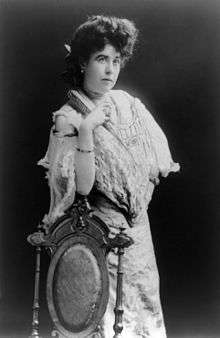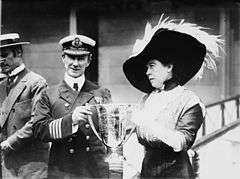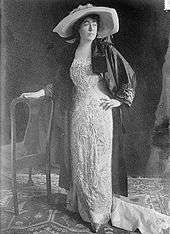Margaret Brown
| Margaret Brown | |
|---|---|
 Brown in 1909 | |
| Born |
Margaret Tobin July 18, 1867 Hannibal, Missouri, U.S. |
| Died |
October 26, 1932 (aged 65) Barbizon Hotel, New York City, New York, U.S. |
| Resting place | Cemetery of the Holy Rood, Westbury, New York, U.S. |
| Residence | Denver, Colorado, U.S. |
| Other names | Maggie Brown, The Unsinkable Molly Brown, Margaret Tobin Brown, Mrs. James J. Brown |
| Occupation | Socialite, activist |
| Known for | RMS Titanic survivor |
| Home town | Hannibal, Missouri, U.S. |
| Salary | $700/month (1909; $18,467 today) |
| Net worth | $238,000 (1922; $3,370,326 today) |
| Religion | Roman Catholicism |
| Spouse(s) | James Joseph Brown (m. 1886–1909; separated) |
| Children | 2 |
| Parent(s) |
John Tobin (1823–1899) Johanna Collins (1825–1905) |
Margaret "Maggie" Brown (née Tobin) (July 18, 1867 – October 26, 1932) (posthumously known as "The Unsinkable Molly Brown"), was an American socialite, philanthropist, and activist. She became famous when, after surviving the 1912 sinking of the RMS Titanic in Lifeboat No. 6, she exhorted the crew to return to the capsize site to look for survivors. It is unclear whether the boat actually returned to look for survivors, and if so, if any survivors were found.[1] During her lifetime, her friends called her "Maggie", but after her death, a 1960 Broadway musical based on her life and its 1964 film adaptation were each entitled The Unsinkable Molly Brown .
Early life
Margaret Tobin was born in a two-room cottage, near the Mississippi River in Hannibal, Missouri, on what is now known as Denkler's alley. Her parents were Irish Catholic immigrants John Tobin (1823–1899) and Johanna Tobin (1825–1905); her siblings were Daniel Tobin (born 1863), Michael Tobin (born 1866), William Tobin (born 1869), and Helen Tobin (born 1871). Brown also had two half-sisters: Catherine Bridget Tobin (born 1856), by her father's first marriage, and Mary Ann Collins (born 1857), by her mother's first marriage. Both of Margaret's parents had been widowed young.
At age 18, Margaret relocated to Leadville, Colorado, with her siblings Daniel Tobin, Mary Ann Collins Landrigan, and Mary Ann's husband John Landrigan; Margaret and her brother Daniel shared a two-room log cabin, and she found a job in a department store.[2] In Leadville, she met and married James Joseph Brown (1854–1922), nicknamed "J.J.", an enterprising, self-educated man. He wasn't a rich man, but she married J.J. for love. She said,
I wanted a rich man, but I loved Jim Brown. I thought about how I wanted comfort for my father and how I had determined to stay single until a man presented himself who could give to the tired old man the things I longed for him. Jim was as poor as we were, and had no better chance in life. I struggled hard with myself in those days. I loved Jim, but he was poor. Finally, I decided that I'd be better off with a poor man whom I loved than with a wealthy one whose money had attracted me. So I married Jim Brown.
Margaret and J.J. were married in Leadville's Annunciation Church on September 1, 1886.[2] They had two children:
- Lawrence Palmer Brown (known as Larry), was born on August 30, 1887 in Hannibal, Missouri. He married Hannah Elizabeth Horton (1890–1985) on January 1, 1911, in Kansas City, Missouri, with whom he had two children: Lawrence Palmer "Pat" Brown, Jr. (1911–1976) and Eileen Elizabeth "Betty" Brown (1913–1974). The marriage failed, and Larry married Hollywood actress, Mildred Gregory (1895–1956) on November 17, 1926, in Beverly Hills, California. This marriage produced no other children. Larry died on April 2, 1949.
- Catherine Ellen Brown (known as Helen), was born on July 22, 1889 in Leadville, Colorado. She married George Joseph Peter Adelheid Benziger (1877– 1970) on April 7, 1913 in Chicago, Illinois and bore him two children: James George Benziger (1914–1995) and George Peter Joseph Adelrich Benziger (1917–1985). Her grandchildren include Bradford Benziger (born December 13, 1944), Katherine Benziger (born July 12, 1947), and Vincent Benziger (born August 3, 1950). Helen died on October 17, 1969.
The Brown family acquired great wealth when in 1893 J.J.'s mining engineering efforts proved instrumental in the production of a substantial ore seam at the Little Jonny Mine of his employers, Ibex Mining Company, and he was awarded 12,500 shares of stock and a seat on the board. In Leadville, Margaret helped by working in soup kitchens to assist miners' families.
In 1894, the Browns bought a $30,000 Victorian mansion in Denver, Colorado, and in 1897, they built a summer house, Avoca Lodge in Southwest Denver near Bear Creek, which gave the family more social opportunities. Margaret became a charter member of the Denver Woman's Club, whose mission was the improvement of women's lives by continuing education and philanthropy. Adjusting to the trappings of a society lady, Brown became well-immersed in the arts and fluent in French, German, Italian, and Russian. Brown co-founded a branch in Denver of the Alliance Française to promote her love of French culture.[3][4]
After 23 years of marriage, Margaret and J.J. privately signed a separation agreement in 1909. Although they never reconciled, they continued to communicate and cared for each other throughout their lives. The agreement gave Margaret a cash settlement, and she maintained possession of the house on Pennsylvania Street in Denver and the summer house, Avoca Lodge in Southwest Denver, near Bear Creek. She also received a $700 monthly allowance (equivalent to $18,467 today) to continue her travels and social work.
Brown assisted in fundraising for Denver's Cathedral of the Immaculate Conception, which was completed in 1911. She also worked with Judge Ben Lindsey to help destitute children and establish the United States' first juvenile court, which helped form the basis of the modern U.S. juvenile courts system.
Brown ran for Senate in 1914 but ended her campaign to return to France to work with the American Committee for Devastated France during World War I.
Passenger on the Titanic

Brown was conveyed to the passenger liner RMS Titanic as a first class passenger aboard the tender SS Nomadic at Cherbourg, France. Some of the other first class passengers disliked her because she was "new money".
The Titanic sank early on April 15, 1912, at around 2:20 a.m., after striking an iceberg at around 11:40 the night before. Brown helped others board the lifeboats but was finally persuaded to leave the ship in Lifeboat No. 6.[1] Brown was later called "The Unsinkable Molly Brown" by authors because she helped in the ship's evacuation, taking an oar herself in her lifeboat and urging that the lifeboat go back and save more people. Her urgings were met with opposition from Quartermaster Robert Hichens, the crewman in charge of Lifeboat 6. Hichens was fearful that if they went back, the lifeboat would either be pulled down due to suction or the people in the water would swamp the boat in an effort to get inside.[1] Sources vary as to whether or not the boat went back and if they found anyone alive if they did, but Brown's efforts sealed her place in history, nevertheless.
Later life

At the time of J.J. Brown's death on September 5, 1922, Margaret told newspapers, "I've never met a finer, bigger, more worthwhile man than J.J. Brown." J.J. died intestate, and five years of disputation between Margaret and her two children were required to finally settle the estate. Due to their lavish spending, J.J. left an estate valued at only $238,000, equal to $3,370,326 today. Maggie was to receive $20,000 in cash and securities (equal to $283,221 today), and the interest on a $100,000 trust fund (equal to $1,416,103 today) in her name. $118,000 was to be divided between her two children, who each received a $59,000 (equal to $835,501 today) trust fund. A court case against Catherine and Lawrence was settled privately, and Margaret and her children were reconciled at the time of Margaret's death in 1932.
Margaret's fame as a well-known Titanic survivor helped her promote the issues she felt strongly about: the rights of workers and women, education and literacy for children, historic preservation, and commemoration of the bravery and chivalry displayed by the men aboard the Titanic. During World War I in France, she worked with the American Committee for Devastated France to rebuild areas behind the front line, and helped wounded French and American soldiers. She was awarded the French Légion d'Honneur for her good citizenship, activism, and philanthropy in America.
During the last years of her life, she was an actress.
Death
Margaret Brown died in her sleep at 10:55 p.m. on October 26, 1932 (during the Great Depression) at the Barbizon Hotel in New York City, New York. Subsequent autopsy revealed a brain tumor. She is buried along with J.J. in the Cemetery of the Holy Rood in Westbury, New York.[5]
Portrayals
- Thelma Ritter (1953) (Titanic). Brown's name was changed to Maude Young, and her Colorado gold mining fortune became a Montana lead mining fortune.
- Cloris Leachman (1957) (Telephone Time) ("The Unsinkable Molly Brown")
- Tucker McGuire (1958) (A Night to Remember)
- Tammy Grimes (1960) (The Unsinkable Molly Brown) (Broadway musical) Grimes won a Tony Award for her performance.
- Debbie Reynolds (1964) (The Unsinkable Molly Brown). Reynolds received an Academy Award nomination for Best Actress.
- Cloris Leachman (1979) (S.O.S. Titanic) (TV movie)
- Fionnula Flanagan (1983) (Voyagers!) ("Voyagers of the Titanic")
- Marilu Henner (1996) (Titanic) (TV miniseries)
- Kathy Bates (1997) (Titanic)
- Judy Prestininzi (2003) (Ghosts of the Abyss) (Documentary)
- Linda Kash (2012) (Titanic) (TV series/2 episodes)
See also
Notes
- 1 2 3 Titanic: A Night Remembered, Stephanie L. Barczewski, 2004, page 30.
- 1 2 Harper, Kimberly. "Margaret Tobin Brown (1867 - 1932)". State Historical Society of Missouri. Retrieved 27 October 2013.
- ↑ Iversen, Kristen (1999). Molly Brown: Unraveling the Myth. Boulder: Johnson Books. pp. 145–146.
- ↑ Iversen, p. 34
- ↑ "Mrs Margaret Brown1 (Molly Brown) (née Tobin)". Encyclopedia Titanica. Retrieved 19 April 2016.
External links
| Wikimedia Commons has media related to Margaret Brown. |
- Unsinkable: the Molly Brown Story
- Margaret Brown On Titanic-Titanic.com
- Margaret Brown Death Certificate On Titanic-Titanic.com
- List of passengers and crew of RMS Titanic
- Margaret Brown at Find a Grave
- Molly Brown House Museum, Denver
- Book, Molly Brown: Unraveling the Myth
- Margaret Brown Titanic Pages biography
- 1920 passport photo of Margaret "Molly" Brown (courtesy flickr.com)